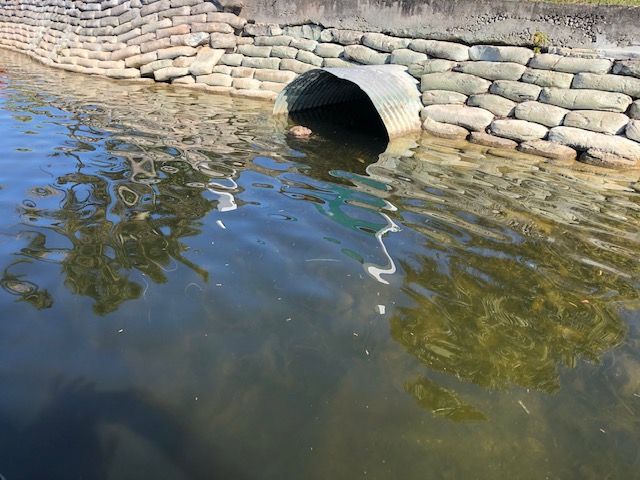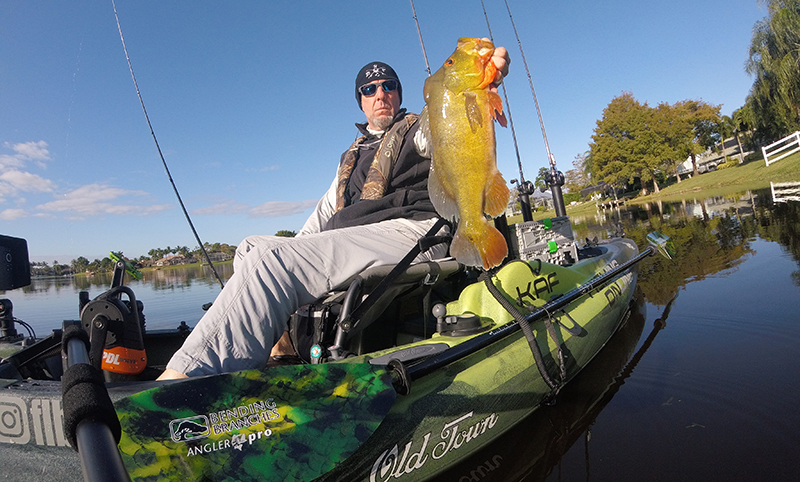Targeting Florida's Peacock Bass In A Fishing Kayak
By: Bill Sikora, Old Town Pro Staff Member
I am fortunate to live in South Florida. Florida winters are nothing like the winters in other parts of the country, which is great if you're an angler. It has been over ten years since we hit freezing temperatures in southeast Florida, which has benefitted many exotic fish species that we find in our waterways. Especially the peacock bass.
It used to be that an angler had to travel to South America to target these ferocious fighters, but the peacock bass are thriving in Florida, and they are an absolute blast to catch. Best of all, you can use your everyday bass tackle to target them.
Peacock bass were introduced in waterways around Miami in 1984 after a lengthy study by the Florida Game and Fish Commission. The theory was that introducing the non-native Cichlid would help control the population of invasive species such as the Spotted Tilapia and the Oscar.
The Peacock Bass population flourished until 2010, when Florida set a record for one of the coldest periods in the state's history. For 12 straight days, air temperatures were 45 degrees or lower, which had a devastating impact on many fish species, including the peacock bass, leading to a large die-off. Since then, thanks to above-average winter temperatures, peacock bass species have made a remarkable comeback.
The peacocks thrive in water that exceeds 60 degrees. The recent warmer-than-average winters have allowed the fish to move further north in Florida, some found as far north as Palm Beach County. Even if the air temperature dips, as long as the water remains above 60 degrees, you can still catch a nice peacock bass.
If peacock bass are a bucketlist fish for you, you're in luck - it's not as difficult as some other game fish to target. Visitors to South Florida can easily book a local fishing guide who specializes in catching peacock bass. If you are more of an enterprising DIY angler, as long as you find where they are, using a free-swimming live shiner on a circle hook will undoubtedly get the job done.
After years of experience, I have found a few favorite go-to peacock lures to target these brutes, some utilize a topwater technique, and others are sub-surface and deep-water techniques.
TOPWATER FISHING FOR PEACOCK BASS
Peacocks love hard-bottom habitat. When fishing against a seawall, near a bridge, or where the bottom structure is rocky or hard, I use a prop bait. My first and favorite lure of choice is a Yo-Zuri 3DB prop bait in Prism Ayu. Many have seen South America footage where a peacock crushes a large topwater lure that an angler aggressively retrieves. The same theory applies while using this lure - it is a scaled-down version of the bait used by South American anglers.

By nature, peacock bass are predatory, so proper presentation is essential. For example, if I am fishing against a seawall, I will cast my lure within 2 feet of the wall. When retrieving, I want the bait to behave erratically, mimicking a fleeing baitfish. I use aggressive jerks, varying the sequence, then will pause, slowly reeling in the slackline. The trick is maintaining composure on the initial strike. Peacocks often follow a bait, creating a wake as they approach, only to back off or false-strike. The key is to watch the line tension to ensure the fish took the bait. I have had fish take 4-5 swipes at a lure before finally committing to it, and it is not uncommon to have multiple fish strike at a bait simultaneously. They are incredibly aggressive fish. Sometimes the smaller fish wreak the most havoc. The topwater technique is by far the most exciting way to get them.
When fishing a topwater presentation, a standard topwater rod and reel combo will get the job done. I use a 6'11" 15-30 lb class frog rod. I like the taper of the frog rod for throwing lighter prop baits. Reels with a high-speed gear ratio (i.e., 8.1:1) allow you to quickly retrieve a slacked line, which is essential given the erratic retrieval methods used to target Peacocks. And 20-pound braided line with a 20 to 30-pound fluorocarbon leader is recommended. The leader helps against abrasion, given the underwater structure your fishing around, and allows for some stretch when fighting bigger fish. Drag settings on your reel are crucial to ensure that you're not stressing the line too much. You will want to use your drag to let the fish run while you tire it out to avoid breaking the fish off during the fight.
SUB-SURFACE PEACOCK BASS FISHING
When fishing slightly deeper water for peacock bass, I still look for the same underwater structure characteristics but change out a topwater lure for a jerkbait lure. From my experience, a white Vense Lures PerchaPro 80 Minnow does a great job of drawing the fish out of deeper areas where there is a sudden drop-off.
Using a similar approach to the topwater prop lure, cast the jerkbait lure parallel to the wall, this time about 3'-4' away from the wall to present the bait right above the underwater drop-off point. Use aggressive, varying twitches to trigger strikes, slowly retrieving to reduce line slack.
While I am more of a baitcaster angler, I prefer a spinning outfit for this technique. When fishing a jerkbait, a standard 7' medium-heavy spinning rod with a moderate-fast taper, coupled with a 1500-sized spinning reel with a 6.2:1 gear ratio is ideal. The moderate-fast taper provides the necessary "spring" action to create the erratic presentation upon retrieval. I recommend rigging your reel with 10-pound braid with a 15-pound fluorocarbon leader. With a lighter line and slower reel gear ratio, the medium-heavy action rod will offer a backbone to pull the fish away from potential break-off points.
DEEP WATER PEACOCK BASS FISHING
When fishing deeper waters, I throw a small lipless crankbait like the Yo-Zuri 3DR Series Vibe, or a heavier spinnerbait like the RedLine Lures Pro Series in 1/2 oz or 3/4 oz. Lipless crankbaits and spinnerbaits, in my opinion, are some of the most versatile lures out there. That's because you control how deep they run by utilizing the countdown method. The countdown method is simple. The general rule is if the bait weighs 1/2 oz, it sinks at a rate of 1' foot per second. Using this method in conjunction with your fish finder will help you locate and target where fish are holding in deeper waters. I use this technique when the temperatures are colder and fish retreat to deeper, warmer water.
Cast the lure at the wall or bank rather than parallel to it. Use the countdown method to present the bait at the desired depth. Use a very slow and steady retrieve to keep the lure presentation in the strike zone. This technique is useful when the fish are lethargic or aren't in the mood for an aggressive chase.
More often than not, treble hooks pull much easier from a fish, so having some give and a proper drag setting will help minimize break-offs or lost fish. I recommend using a baitcasting rod with a moderate-fast taper and a reel with a 5.5:1 gear ratio and 10-pound monofilament line. The moderate-taper gives the rod some "spring" that helps the bait mimic a fleeing baitfish. The lighter line enhances casting distance but is susceptible to breakage, so mind your reel's drag setting. I use this technique in deeper, open water where there is less structure for a fish to break off.

The peacock bass is an incredibly resilient and hardy fish. If Florida winters continue to trend warmer, the species will continue to thrive, grow, and adapt in their home away from home in Florida's vast lakes and canal systems. Peacock bass are one of the most sought-after game fish in South Florida - the next time you find yourself headed to the Sunshine State, pack your fishing gear and come find out why. The peacock bass is here, waiting to take you on.
Old Town pro staff member Bill Sikora lives in Deerfield Beach, Florida. He has been kayak fishing since 2004 and absolutely loves fishing freshwater for largemouth and peacock bass. Follow Bill’s fishing adventures on Instagram @flbasspaddler






